Abstract
Rationale: The development of miniaturized and field portable mass spectrometers could not succeed without a simple, compact, and robust ionization source. Here we present a voltage-free ionization method, Vibrating Sharp-edge Spray Ionization (VSSI), which can generate a spray of liquid samples using only one standard microscope glass slide to which a piezoelectric transducer is attached. Compared with existing ambient ionization methods, VSSI eliminates the need for a high electric field (~5000 V·cm-1 ) for spray generation, while sharing a similar level of simplicity and flexibility with the simplest direct ionization techniques currently available such as paper spray ionization (PSI) and other solid substrate-based electrospray ionization methods.
Methods: The VSSI device was fabricated by attaching a piezoelectric transducer onto a standard glass microscope slide using epoxy glue. Liquid sample was aerosolized by either placing a droplet onto the vibrating edge of the glass slide or touching a wet surface with the glass edge. Mass spectrometric detection was achieved by placing the VSSI device 0.5-1 cm from the inlet of the mass spectrometer (Q-Exactive, ThermoScientific).
Results: VSSI is demonstrated to ionize a diverse array of chemical species, including small organic molecules, carbohydrates, peptides, proteins, and nucleic acids. Preliminary sensitivity experiments show that high-quality mass spectra of acetaminophen can be obtained by consuming 100 femtomoles of the target. The dual spray of VSSI was also demonstrated by performing in-droplet denaturation of ubiquitin. Finally, due to the voltage-free nature and the direct-contact working mode of VSSI, it has been successfully applied for the detection of chemicals directly from human fingertips.
Conclusions: Overall, we report a compact ionization method based on vibrating sharp-edges. The simplicity and voltage-free nature of VSSI make it an attractive option for field portable applications or analyzing biological samples that are sensitive to high voltage or difficult to access by conventional ionization methods.
Figures
Figure 1.
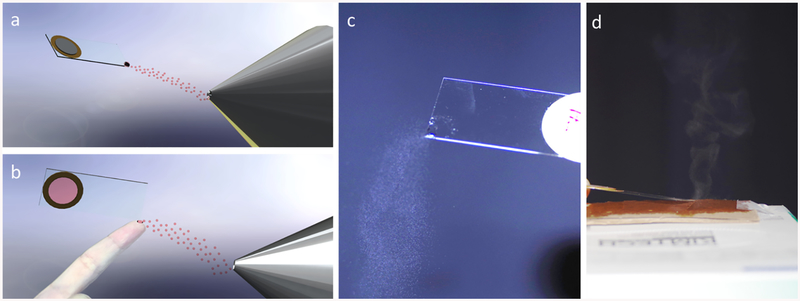
Schematic diagram of VSSI. a) On-substrate spray working mode of VSSI. b) In-situ direct-touch working mode of VSSI. c) Real image of on-substrate direct spray. Frequency: 97.1 kHz; Voltage: 12.7 Vpp. d) Real image of direct-touch spray generation on damp cardboard. Frequency: 97.1 kHz; Voltage: 18.0 Vpp. The contrast of images was enhanced to facilitate the visualization of fine droplets.
Figure 2.
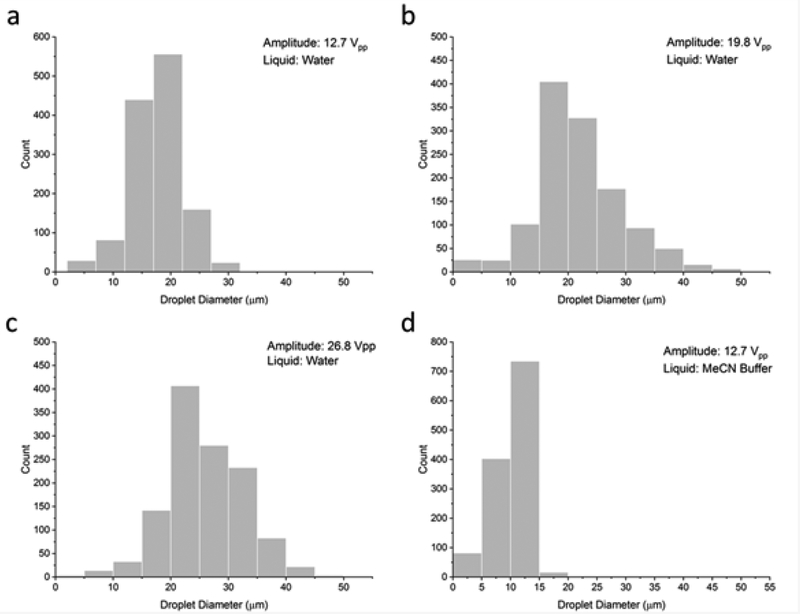
Size distributions of droplets generated by VSSI under different power input conditions and for different solvent systems. a)-c) Liquid: water. Voltage: 12.7, 19.8, 26.8 Vpp, respectively. d) Liquid: H2O:MeCN (1:1) with 1% acetic acid. Voltage: 12.7 Vpp. Number of droplets counted: >1000.
Figure 3.
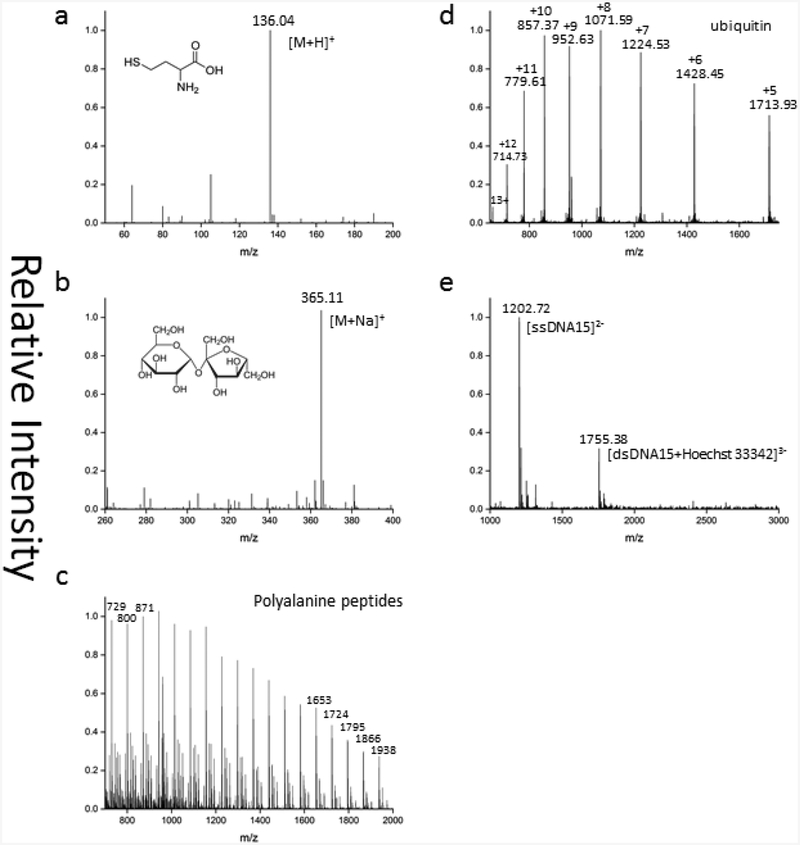
Mass spectra of a) homocysteine (1 mM); b) Sucrose (1 mM); c) polyananine peptides; d) ubiquitin (1 mM); e) DNA duplex with Hoechst 33342. Sequence: CAAATTTG Solvent: H2O:MeCN (1:1) mixture containing 1% HOAc. Capillary Temperature: 250 °C
Figure 4.
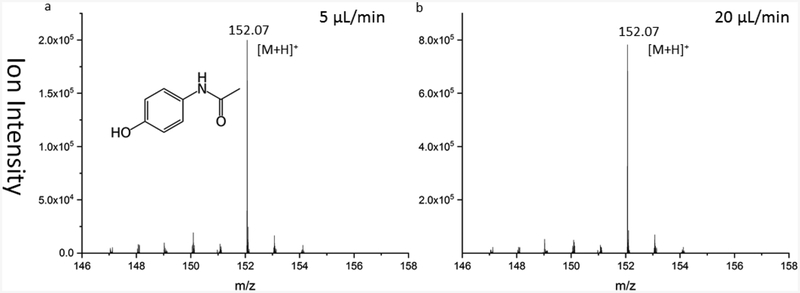
Mass spectra of 1 uM acetaminophen at flow rates of a) 5 μL/min b) 20 μL/min. Solvent: H2O:MeCN (1:1) mixture containing 1% HOAc. Capillary Temperature: 450 °C
Figure 5.
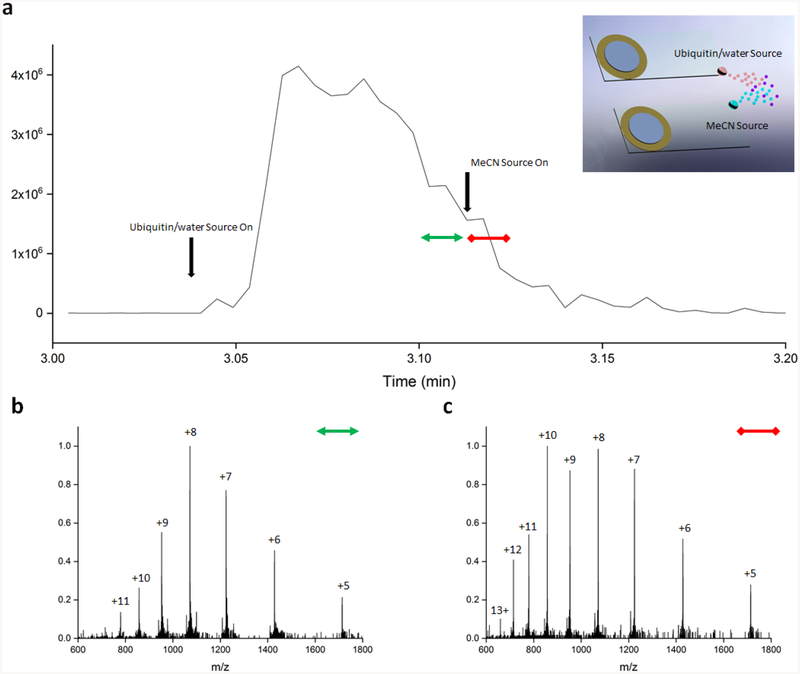
In-droplet denaturation of ubiquitin by MeCN. a) Ion chronogram of two VSSI sources in operation. At 3.04 min, the source with the ubiquitin in water droplet was turned on. After 3.11 min, the second MeCN source was turned on to generate MeCN droplets for denaturation. b) Mass spectrum of ubiquitin prior to turning the MeCN source on. d) Mass spectrum of ubiquitin immediately after turning the MeCN source on. Capillary Temperature: 250 °C
Figure 6.
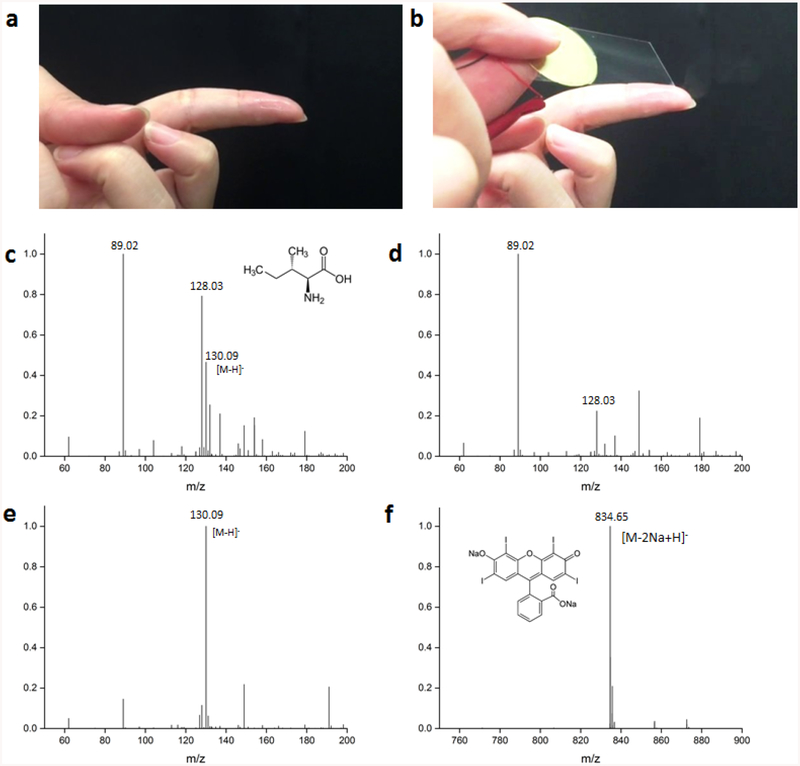
In-situ analysis of trace chemicals on human fingertips with VSSI. a) Image of a wet finger. b) Direct spray generation from the wet finger with VSSI. c) Mass spectrum obtained from direct spray of a finger exposed to isoleucine powder. d) Mass spectrum obtained from the direct spray from a finger not exposed to isoleucine powder. e) Mass spectrum obtained from on-substrate direct spray of 1 mM isoleucine solution. f) Mass spectrum from direct spray of a finger stained with red food dye, erythrosine. The mass analyzer was operated in negative ion mode for these analyses. Frequency: 97.1 kHz. Amplitude: 12.7 Vpp. Capillary Temperature: 250 °C

